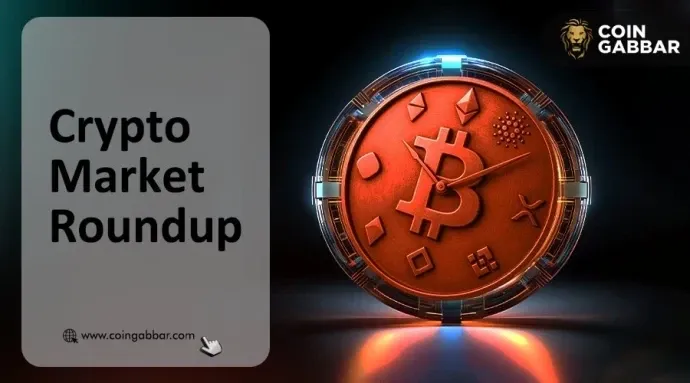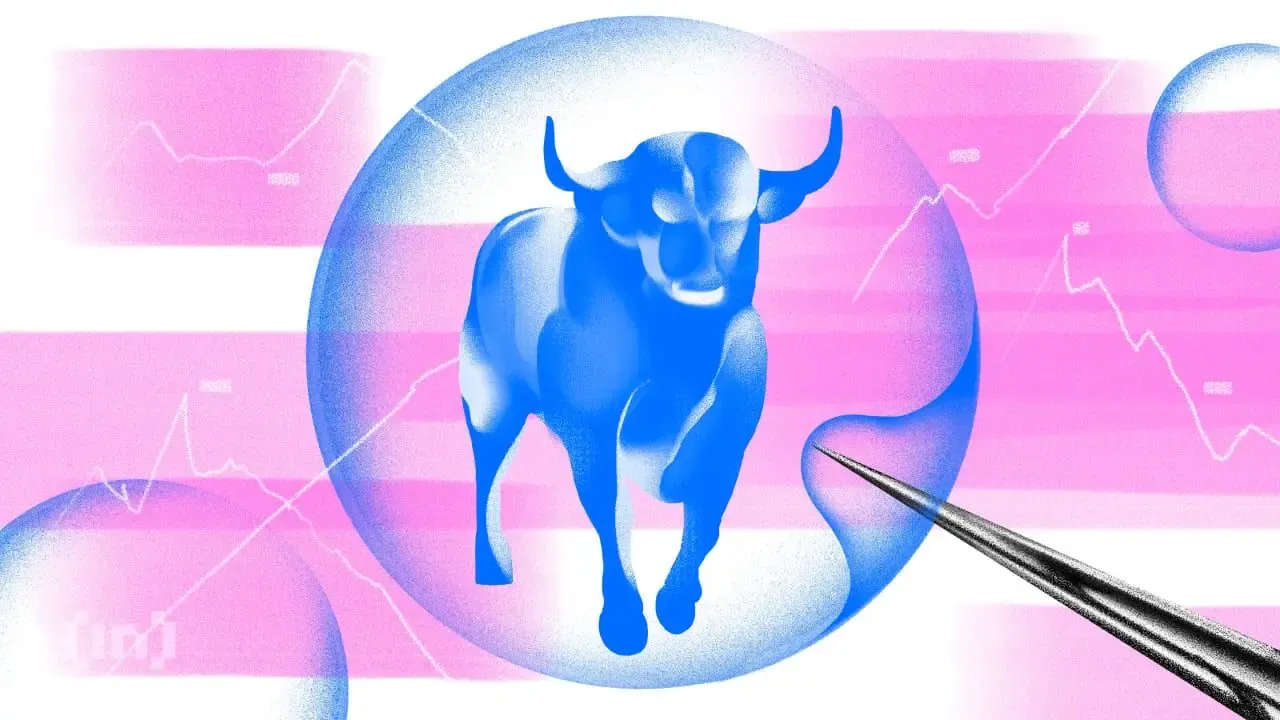Author: Lacie, Bitget Wallet Researcher
I. Introduction: The "Payment Gap" Between Web2 and Web3
The current digital ecosystem is being torn apart by the inherent opposition between Web2 and Web3. On one hand, the convenient payments of Web2 (such as Apple Pay and WeChat Pay) are firmly locked within "walled gardens" by centralized platforms and regional boundaries; on the other hand, while Web3 promises a globally open and permissionless financial future, its severe price volatility and complex user experience have turned it into a "technical island" that mainstream users find daunting.
The gap between "convenience" and "openness" has long burdened Web3 with labels of "difficult to implement" and "speculative hype." Against this backdrop, an open protocol called x402 has entered the public eye. Its proposed solution is quite innovative: rather than starting from scratch, it attempts to activate an internet underlying standard that has been dormant for 26 years—HTTP 402 (Payment Required).
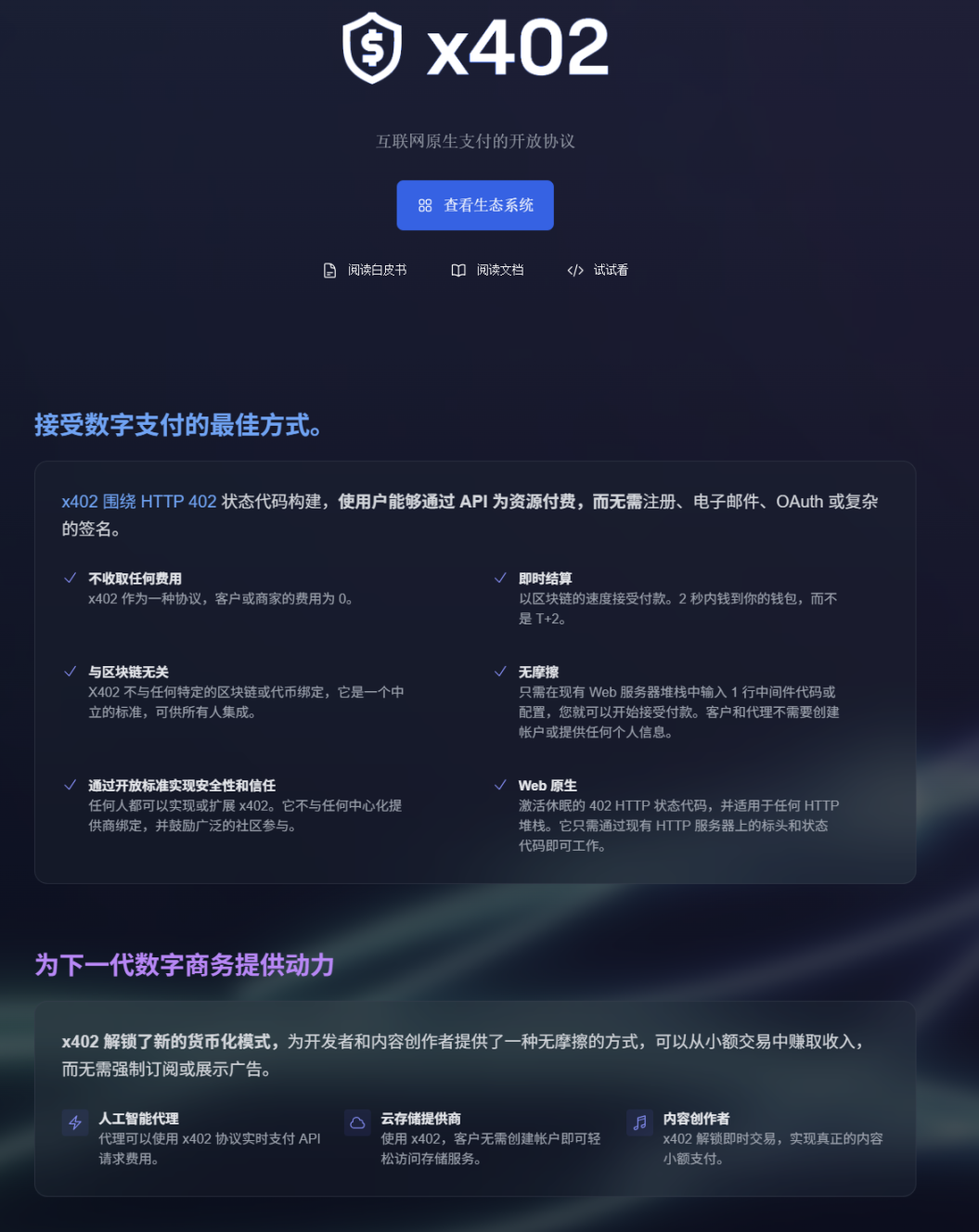
Figure: Introduction image from the x402 official website
Source: x402 Official Website (https://www.x402.org/)
Can this "reactivation" of the internet's underlying protocol standard become the key to bridging the aforementioned gap? Does it herald the birth of a native, open Web payment layer that will fundamentally reshape the flow of value on the internet? Bitget Wallet will take you through a deep analysis of this in the following article.
II. Late Bloom: What is x402 and Why is it Only Now "Going Viral"?
x402 is an open protocol led by Coinbase and open-sourced in May 2025. Its core goal is to activate the long-unused HTTP 402 status code, transforming it into an internet-native, permissionless payment mechanism, ultimately establishing a channel between Web2 applications and the value networks of Web3.
However, an interesting phenomenon is that the x402 protocol went live in May but only suddenly gained popularity after five months of silence. In fact, the 402 status code itself is not a "new invention" in the crypto world; it is a reserved code from the HTTP protocol of the 1990s.
So, why has an "old standard" and a "not-so-new" protocol only recently sparked market discussions? The table below outlines the key timeline from the birth of x402 to its surge in popularity, helping us understand the facts behind this "delayed explosion."

Table: Timeline of the birth and application of x402 (as of October 28, 2025)
Source: Bitget Wallet compiled from public data (with trading data from x402scan)
As shown in the timeline above, the evolution path of x402 reveals several key facts:
- First, x402 is a modern application based on the 1999 HTTP 402 status code, which has been "archived" for a long time due to a lack of application scenarios.
- Second, the x402 protocol was initiated by Coinbase and quickly gained support and integration from Web2 giants like Google, Cloudflare, and Visa within a few months.
- Third, although the protocol has been released for several months, what truly made it "go viral" was the recent surge of Meme coins that capitalized on the x402 concept.
In short, the current popularity of x402 is the result of a combination of a technological vision (AI Agent payments) and speculative frenzy (driven by Memes). But aside from the market noise, we should focus more on its technical core—how does it actually work?
III. Unlocking and Internalizing: How Does x402 Activate the Dormant HTTP 402?
To understand x402, we must look back to the 1990s. The internet transmitted information between clients and servers through the HTTP protocol (HyperText Transfer Protocol). HTTP defines a series of response status codes (HTTP Response Status Codes) to represent specific functions, such as the well-known "404 Not Found" or "200 OK" (request successful).
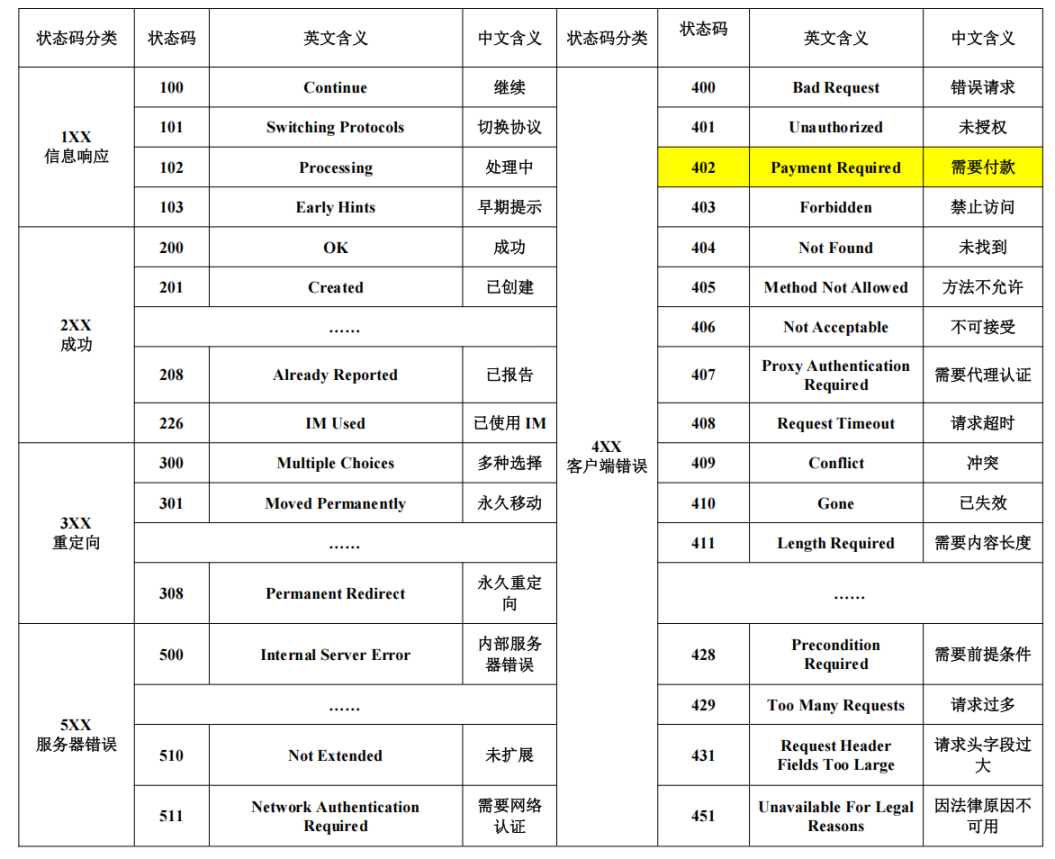
Table: Summary of HTTP Status Codes
Source: Compiled by Bitget Wallet
In this vast code system, the 402 (Payment Required) status code is particularly special. It was originally designed to envision a protocol-native micropayment method, hoping to achieve "instant payments that connect seamlessly like loading an image"—without intermediaries and delays. However, as the internet economy shifted towards advertising, platforms, and complex credit card forms, the concept of the 402 status code was shelved, and the standard has never been scaled for use.
The emergence of x402 is precisely to "unseal" the value of the 402 status code. Its workflow is logically quite ingenious:
- When a user requests a paid resource, the server no longer returns a "redirect" instruction (leading to a subscription page) but directly returns a 402 status code. This response contains all the key information needed to complete the payment: the receiving address, payment amount, supported blockchain networks (such as Base, Polygon, etc.), and currency type (such as USDC).
- Clients that support x402 (such as browser plugins or Web3 wallets) will automatically "translate" this 402 request into a payment prompt once captured, requiring the user to simply click to confirm. The wallet then completes the stablecoin payment through an efficient L2 network and notifies the server after the transaction is confirmed. The server verifies the receipt and immediately unlocks the content for the user.
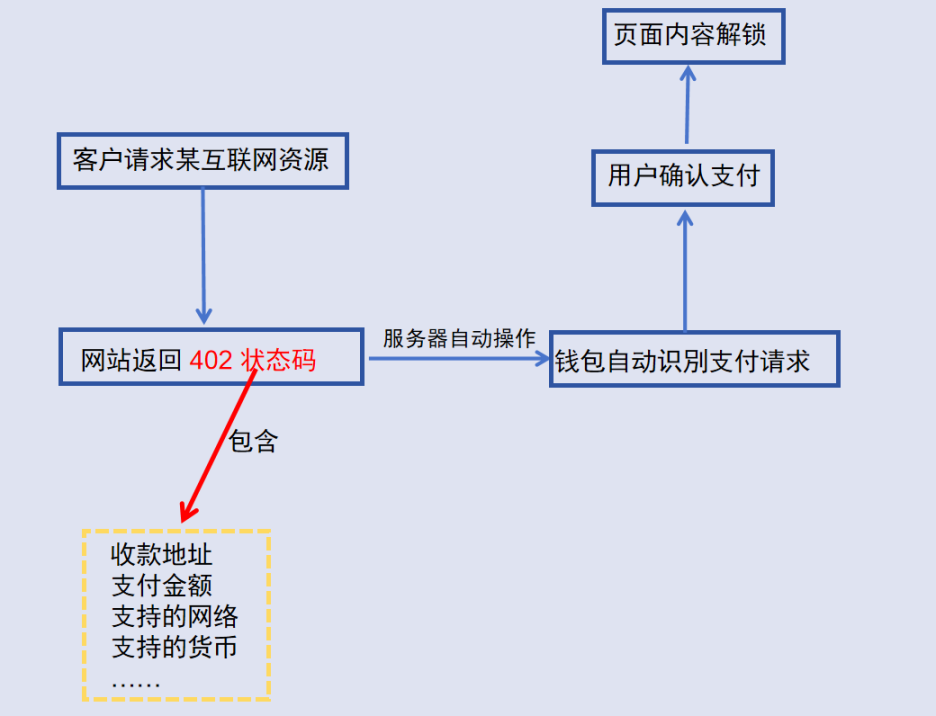
Figure: x402 Workflow Diagram
Source: Compiled by Bitget Wallet
The entire process internalizes payment as part of the HTTP protocol, making it a native interaction of the browser, akin to loading an image or accessing a non-existent page. It essentially embeds a native "value settlement" function into the most fundamental communication layer of the internet, enriching the underlying internet transmission protocol that has been in use for over 20 years at the application level.
IV. Timing is Right: Why Now?
A reasonable question is: The HTTP 402 standard has existed for 26 years; why has it only now found a real opportunity for implementation through x402? The answer lies in the simultaneous presence of the "three essential elements" of supply, demand, and catalysts.
First is the explosive demand side. The "machine economy," represented by AI Agents, is rapidly rising. AI needs to autonomously and frequently call upon other AI or API services and data. This machine-to-machine (M2M) automation and cross-platform micropayments cannot be supported by traditional credit card systems. x402 embeds payments into HTTP requests, perfectly meeting the "fine-grained" payment demand based on API call billing.
Second is the maturity of the supply-side technology. The infrastructure of the Web3 world has significantly improved. The "digital cash track" that was missing when the 402 standard was conceived has now been filled by Layer2, high-performance public chains, and widely circulated stablecoins. The second-level confirmations and extremely low costs they provide make native internet micropayments economically feasible.
Finally, strong promoters serve as key catalysts. Coinbase has open-sourced the protocol specifications, while Google and Visa have endorsed it, and infrastructure giants like Cloudflare have jointly initiated the x402 Foundation. These forces are collectively committed to promoting x402 as a new type of "open internet standard," greatly lowering integration barriers and accelerating ecosystem formation.
It is precisely during this window period where technology (supply) and demand (AI) intersect, combined with the push from industry giants (catalysts), that x402 has seized the opportunity of infrastructure readiness, transforming from a dormant concept into a practical application.
V. Singularity and Hidden Reefs: The Imagination Space and Triple Challenges of x402
As described in the x402 white paper (as shown in the figure below): the most direct application of the x402 protocol is to open the door to the "machine economy" for AI Agents. In the future, AI entities will undoubtedly become major participants in the internet. The x402 protocol, being native and programmable, naturally aligns with the economic needs of M2M (machine-to-machine). It allows an AI entity to autonomously call another AI's API service and automatically pay a fee of 0.0x dollars through x402, without human intervention for preloading, significantly reducing friction costs between services.
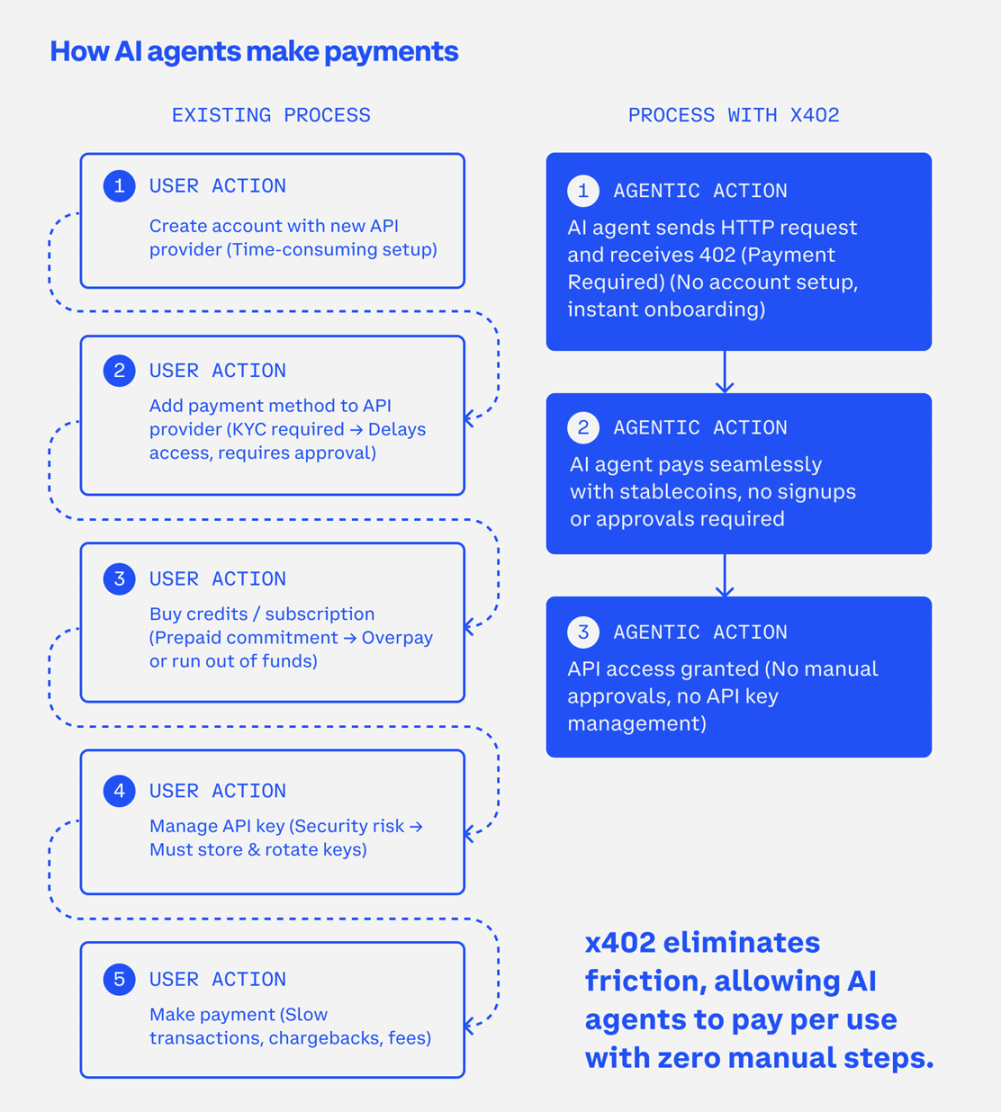
Figure: Comparison of Existing Agent Payment Processes and x402 Pay-Per-Use Model
Source: x402 White Paper
Its more profound significance lies in the fact that x402 allows an HTTP request to simultaneously possess the dual attributes of "data transmission" and "value transmission." This integrates the dimension of "value" into the information protocol that was born at the inception of the internet, genuinely promising to revolutionize the traditional WEB system that has been in use for over 20 years at the application level.
At the same time, this may also provide an answer to a long-standing pain point of Web3: how can the crypto world empower the real world and change it? For a long time, the crypto world has been criticized for lacking truly mainstream applications, and x402 may very well become such a singularity—it does not start from scratch but attempts to "inject" the value settlement capabilities of Web3 into the vast ecosystem of Web2, becoming a true bridge connecting the two worlds—this is also the fundamental logic behind the protocol being pursued and discussed by countless people.
However, behind the optimistic vision, the challenges faced by x402 are equally significant.
First, there are concerns from within the HTTP protocol itself. The HTTP 402 status code is still an "unstandardized" reserved code. As indicated by the MDN Web Docs (developer documentation library), it is defined as "reserved but not defined." This means it has not been fully accepted by mainstream web standards, leading to compatibility issues with the underlying protocol. Therefore, the current implementation of x402 largely relies on custom HTTP headers like X-PAYMENT rather than the true standard 402 status code, casting a shadow over its long-term standardization.

Figure: Compatibility issues with the HTTP 402 status code pointed out by the developer documentation library
Source: MDN Web Docs
Secondly, the subsequent attitudes of traditional internet giants remain to be seen. Although giants like Google have announced their acceptance of this protocol within the AI framework, the concept of "bypassing platforms for peer-to-peer payments" advocated by x402 essentially stands in opposition to the current internet giants that profit from "walled gardens" and payment commission models. The combination of x402 and AI Agents feels more like a "declaration of war" against the traditional internet ecosystem—whether the giants' attitude is one of genuine acceptance or temporary exploitation remains to be observed.
Finally, and most alarmingly, is the potential backlash from speculative bubbles. Since the x402 protocol itself has not issued any tokens, all tokens associated with it in the market (such as PING) are experimental meme projects. While the meme frenzy has objectively boosted the popularity of x402, it raises a deep concern: will this movement once again fall into the false prosperity of "speculative narratives," thereby undermining the true technological ideals when the bubble bursts? This is a dilemma that the crypto world has always struggled to escape. (The following image shows the ecological landscape of x402)
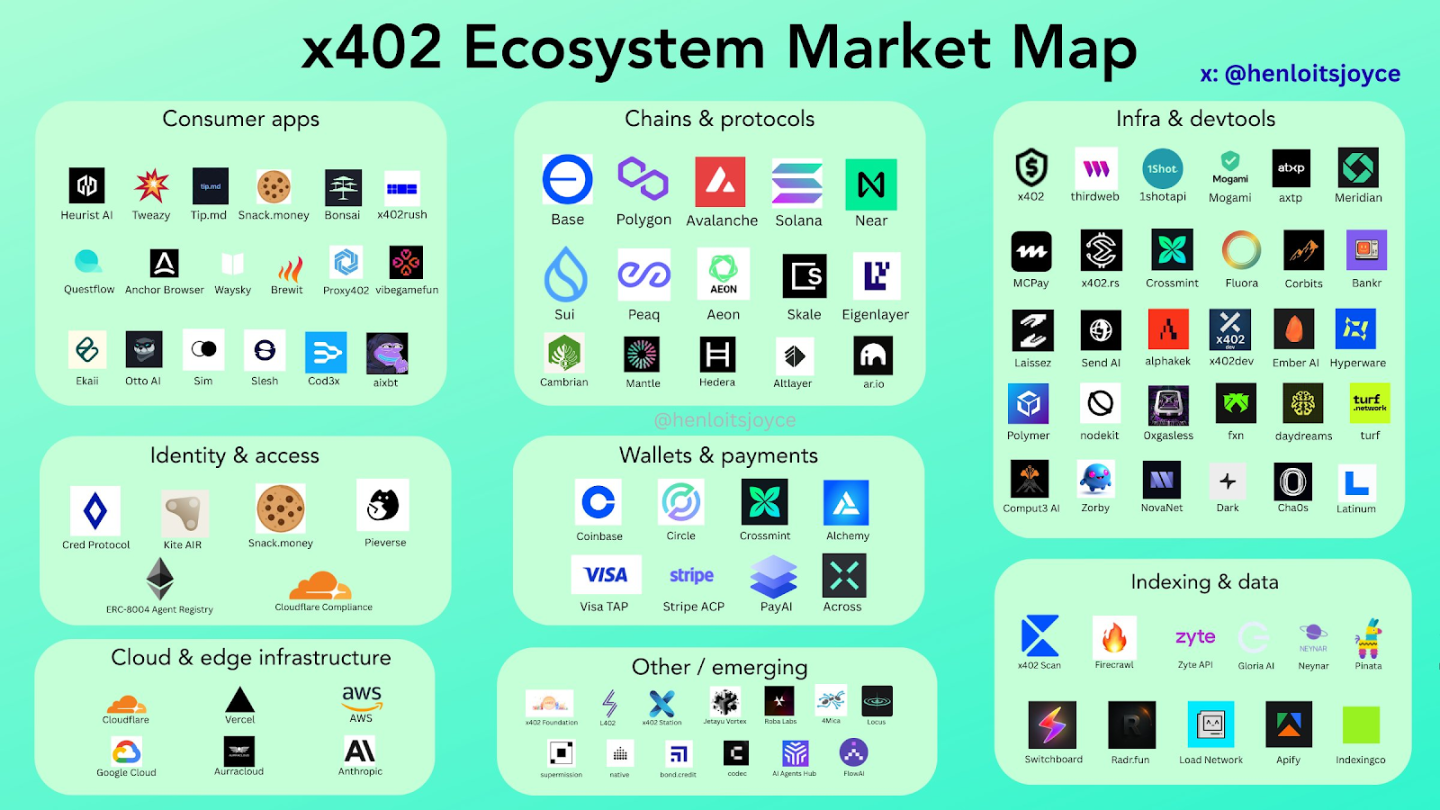
Figure: Overview of the x402 ecosystem
Source: X @henloitsjoyce
VI. Conclusion: Amidst the Clamor, What is the Value?
x402 provides an extremely pragmatic solution for AI Agent payments—it does not require users to abandon the existing internet but attempts to achieve a critical upgrade of "payment" at the most fundamental protocol level. Looking back at the entire development process of x402, it is quite ironic that what truly made x402 "go viral" was not its ingenious technical concept, but rather the speculative frenzy of meme coins in late October. This suggests that many of the voices analyzing the disruptive potential of x402 are "seeing the bubble first and then retroactively attributing meaning."
The current x402 craze is more driven by speculative narratives than by technological breakthroughs. This raises a core question: is x402 a milestone in the integration of Web3 and Web2, a true singularity pushing the internet into the "value layer"? Or is it merely a lifeline that the crypto market has grasped while searching for the next "hundredfold narrative"?
The answer still requires time to verify. However, regardless, the concept of a "native HTTP value layer" indicated by x402 has provided a profound exploration direction for empowering Web2 with Web3. This contemplation of future forms holds far more weight than the transient market clamor.
免责声明:本文章仅代表作者个人观点,不代表本平台的立场和观点。本文章仅供信息分享,不构成对任何人的任何投资建议。用户与作者之间的任何争议,与本平台无关。如网页中刊载的文章或图片涉及侵权,请提供相关的权利证明和身份证明发送邮件到support@aicoin.com,本平台相关工作人员将会进行核查。

